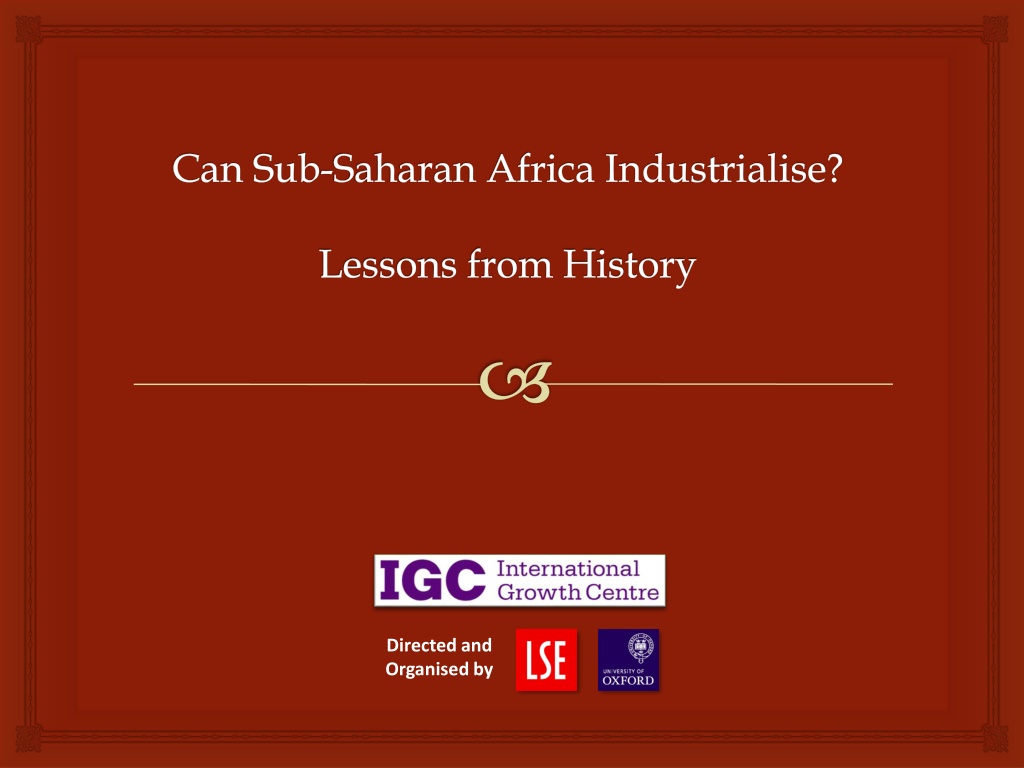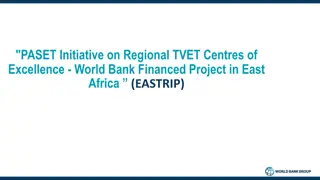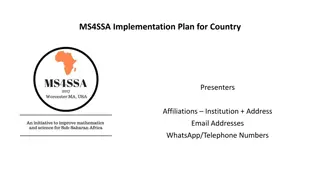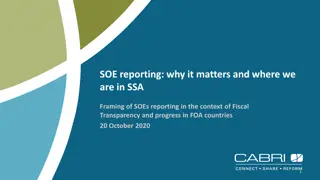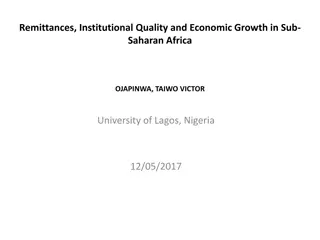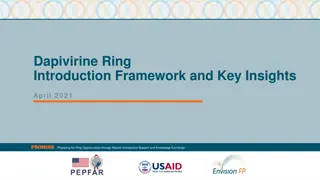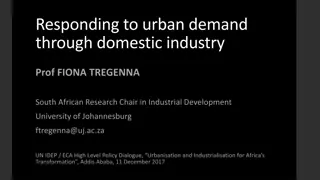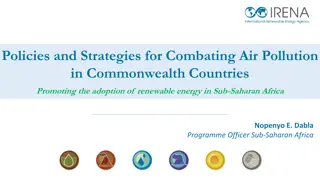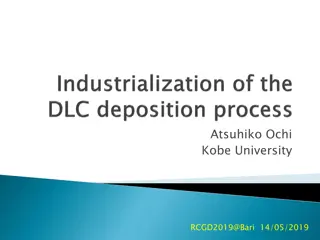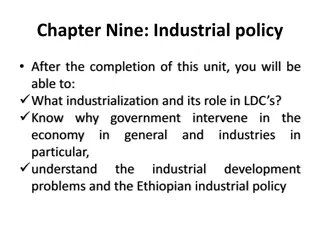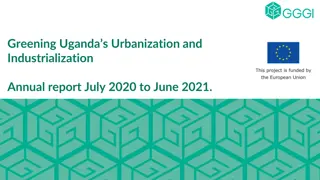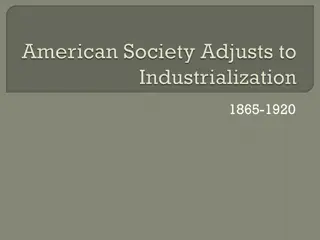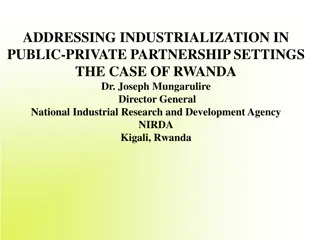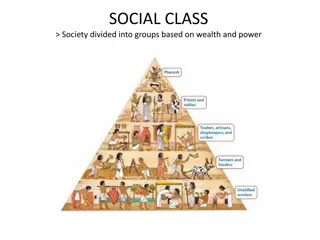Industrialization Prospects in Sub-Saharan Africa: Lessons and Success Stories
Sub-Saharan Africa is witnessing rapid economic growth in countries like Ethiopia, Ghana, Mozambique, Tanzania, and Zambia across various sectors. Sustainable growth could elevate them to middle-income status, although challenges remain in maintaining such growth rates. The industrial output has doubled, highlighting the potential for further industrialization. Key industries driving this growth include food, drink, metals, plastics, and building materials, with entrepreneurs contributing to new developments.
Download Presentation

Please find below an Image/Link to download the presentation.
The content on the website is provided AS IS for your information and personal use only. It may not be sold, licensed, or shared on other websites without obtaining consent from the author. Download presentation by click this link. If you encounter any issues during the download, it is possible that the publisher has removed the file from their server.
E N D
Presentation Transcript
Can Sub-Saharan Africa Industrialise? Lessons from History Directed and Organised by
Success Stories Five of the larger Sub-Saharan countries have grown rapidly over the past decade Ethiopia, Ghana, Mozambique, Tanzania, Zambia. This growth is broadly based across the several sectors of their economies If these growth rates can be sustained for another decade, these countries can become middle income countries But can these growth rates be maintained? 2
The change in size and composition of GDP Ethiopia Zambia Ghana Mozambique Tanzania 10 10 25 20 20 9 9 18 18 8 8 20 16 16 7 7 14 14 6 6 15 12 12 5 5 10 10 4 4 10 8 8 3 3 6 6 2 2 5 4 4 1 1 2 2 0 0 0 0 0 2000 2010 2000 2010 2000 2009 2000 2010 2000 2010 Construction Other Whole, Retail Trade etc. Agriculture Manufacturing Mining and Utilities (billions of real US$; base year 2005) 3
Remark The rise in raw materials prices is best seen as a one-off step change in GDP levels, rather than an ongoing potential source of growth. The Agricultural sector will continue to be a key contributor to growth but the shift of population out of agriculture will be a vital part of the process too (see below) The volume of industrial output has more-or-less doubled in a decade: my main focus in this talk lies in asking, (How) Can this continue? 4
The Range of Industrial Activity What are the industries we see (almost) everywhere? Food, Drink: Wide range, Sugar, Beer Metals: Drawn Wire, Galvanized Sheet Plastics: Moulded Products, Heavy Pipes Building Materials: Cement, Bricks, Tiles Within this range of Industries, there are some really excellent companies Bakhressa Flour Mills, Tanzania Lafarge Cement, Zambia 5
And what kinds of entrepreneurs are driving new developments? An SME Trader turns manufacturer: Drawn Wire in Ethiopia (Mohan Kothari) Soft Drinks produced domestically (Access Capital, Ethiopia) A De Novo Major Domestic Firm broadens the industrial base: Steel making in Zambia Kafue Steel, Zambia (Dr. Julius Kaoma) A Multinational Example of Global Standards: Cement in Zambia (Lafarge) Global Excellence in an Established Large Domestic Firm example: Flour Milling in Tanzania (Bakhresa) Two individual small businessperson examples: (a) Ghana s Metal Fabrication Ltd. (B. K. Amandi) (b) Tanzania s Power Foods Ltd (Anna Temu) The lesson is that there are many channels, all producing real advances in the range and quality of output. 7
Basic Manufacturing Selling to a safe local market High transport costs or tariffs protect from imports There is no international supply chain with other firms whose quality standards you must meet It is this last point that looms largest as we move to Middle Manufacturing 8
The Two Frontiers for Industrial Development 1. Growing existing industries 2. Broadening the Industrial Base into Middle Manufacturing In this talk, I am going to focus on the second point. 9
Broadening the Industrial Base into Middle Manufacturing Growing the industrial sector usually depends to a major degree on broadening the range of activity into middle manufacturing (Mechanical/Electrical/Chemical/Medical/Transport etc.) 10
Index of Weight of Middle Manufacturing vs. Manufacturing Output per capita(US$) in 2006 11
Lessons from History Over the past 50 years, a fairly small number of countries have experienced a transition from a very low level of manufacturing output per capita (less than $3500 in 1964) to a very high level (above $7000 in 2006). These are Ireland, Israel, Republic of Korea, Portugal, Singapore, Spain. 12
Median Product Index vs. Manufacturing Output Per Capita (Ireland) 13
Median Product Index vs. Manufacturing Output Per Capita (Israel) 14
Median Product Index vs. Manufacturing Output Per Capita (Republic of Korea) 15
Median Product Index vs. Manufacturing Output Per Capita (Portugal) 16
Median Product Index vs. Manufacturing Output Per Capita (Singapore) 17
Median Product Index vs. Manufacturing Output Per Capita (Spain) 18
Median Product Index vs. Manufacturing Output Per Capita (China) 19
Median Product Index vs. Manufacturing Output Per Capita (India) 20
Lessons From History For these 6 fast Industrialisers, the growth of the manufacturing sector was associated with a major broadening of the pattern of activity into middle manufacturing. 21
Understanding the Transition to Mid-level Manufacturing The story of India, China and Eastern Europe in the 1990s The story of Ireland in the 1970s The (contrasting) story of South Korea in the 1980s Fundamental Ideas: Working Practices Technical Know-How Level of sophistication Quality as the key driver Working practices as the foundation of quality The role of MNCs and the (limited) prospects for Going it Alone (from South Korea s semiconductors, to India s Bharat Steel How vertical linkages to new MNCs drove quality escalation in India and China 22
The Drivers of Capability Growth For these 6 fast industrialisers, a huge part of the broadening into middle manufacturing was driven by FDI. The relative importance of FDI varies widely across the 6 countries (maximal in Ireland, minimal in Korea). 23
How are Capabilities Built? Lessons from India and China 1. Greenfield Operations 2. Education and Skills 3. Domestic Supply Chains 24
Literacy % Years of Schooling 8 100% Ireland Israel Ireland Spain Ghana Zambia Zambia 80% 6 Singapore Tanzania Republic of Korea Tanzania Portugal Ghana Mozambique 60% Republic of Korea Spain 4 Ethiopia Singapore 40% Portugal Ethiopia 2 Mozambique 20% 25 ~ 1964 ~ 1964 ~ 2009 ~ 2009
Attracting and Benefiting from FDI Relative to the goal of Industrialization, there are two agencies of government that must play a central role: The Investment Agency (For general manufacturing) The Local Content Unit (In the case of resource-rich economies) 26
Two Central, Recurring Issues 1. Reforming Investment Agencies 2. Integrating Domestic Firms into Oil and Gas Industry Supply Chains 27
Raising the population of well functioning mid size firms The Local Content Office Natural Resource MNCs Broadening the range of industrial activity General Manufacturing MNCs The Investment Agency 28
Relationship Building as the key to success in Investment Agencies The key to expanding, reshaping and focusing on relationship building is: 1. A drastic re-assessment of priorities 2. New staff hires, and training 3. A cultural shift in the approach to relations: anticipatingproblems versus putting out fires 29
A Local Content Unit for Resource-Rich Economies A Window of Opportunity A Bargaining Power Reversal Building Industrial Capabilities through integration in the Supply Chain Learning from Global Best practice 30
Strengthening Domestic Firms while independent agencies, such as Technoserve, do excellent work in building SMEs capabilities, and while Export Readiness schemes have great value, the most powerful engine of capability building lies in firm-to-firm interactions in supply chains 31
Strengthening Domestic Firms so the work of independent agencies can have a multiplier effect if it readies domestic firms for supplier tendering 32
The Other Frontier I do not want my emphasis on the broadening theme to create an impression that it is more important than the growing existing activities theme. A good industrial policy would put EQUAL emphasis on both a. Growing existing activities via domestic or foreign firms, for short run employment impact (big plants in clothing and textiles etc.) b. Broadening the range of activities into middle manufacturing in order to build capabilities that will have their greatest export and employment impact in the medium term. 33
